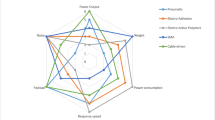Abstract
The compliance mechanisms used on robotic arms can be classified into two major categories: mechanical and electronic. The ideal characteristics of a compliance mechanism include small volume, simple mechanical structure, low cost, large complaint range, and high precision and accuracy under displacement control. Most mechanical compliance mechanisms are able to meet the first three conditions but have a small compliant range and low precision and accuracy under displacement control. The electronic compliance mechanism is hardly limited in the degree of deformation and comes with a higher precision and accuracy under the displacement control, but its sensors are expensive and the system is difficult to control. To combine the advantages of both types, this research aims to develop a new design of compliance mechanism in which a small-scale torque-limiting mechanism with a self-locking feature is installed between the actuator and the arm structure to minimize the volume while providing an ample torque limit. When the robotic arm is overloaded under an external force, a slide will occur inside the compliance mechanism so that the robotic arm will move along the direction of the external force to avoid damage. The robotic arm will automatically return to its original position after the external force is removed. The new compliance mechanism not only exceeds most of the current mechanical designs in the range of compliance but also does not affect the precision and accuracy of the displacement control. Furthermore, the new compliance mechanism does not require any sensors, which will benefit small robotic arms.
Similar content being viewed by others
References
Shetty, B.R., Ang, M.H., Jr.: Active compliance control of a PUMA 560 robot. International Conference on Robotics and Automation, 4, 3720–3725 (1996)
Muis, A., Ohnishi, K.: Cooperative mobile manipulator with dual compliance controllers based on estimated torque and visual force. IEEE International Conference on Mechatronics 619–624 (2006)
Hasegawa, Y., Mikami, Y., Watanabe, K., Sankai, Y.: Five-fingered assistive hand with mechanical compliance of human finger. IEEE Int. Conf. Robot. Autom. 718–724 (2008)
Kajikawa, S.: Variable compliance mechanism for human-care robot arm. 33rd Annual Conference of the IEEE Industrial Electronics Society, 2736–2741 (2007)
Kajikawa, S.: Development of a robot finger module with multi-directional passive compliance. IEEE/RSJ International Conference on Intelligent Robots and Systems 4024–4029 (2006)
Lee, S.: Development of a new variable remote center compliance (VRCC) with modified elastomer shear pad (ESP) for robot assembly. IEEE Transactions on Automation Science and Engineering 2, 193–197 (2005)
Park, J.J., Kim, B.S., Song, J.B., Kim, H.S.: Safe link mechanism based on passive compliance for safe human-robot collision. IEEE Int. Conf. Robot. Autom. 1152–1157 (2007)
Park, J.J., Lee, Y.J., Song, J.B., Kim, H.S.: Safe joint mechanism based on nonlinear stiffness for safe human-robot collision. IEEE Int. Conf. Robot. Autom. 2177–2182 (2008)
Ham, R.V., Vanderborght, B., Damme, M.V., Verrelst, B., Lefeber, D.: MACCEPA: the mechanically adjustable compliance and controllable equilibrium position actuator for ‘controlled passive walking’. IEEE Int. Conf. Robot. Autom. 2195–2200 (2006)
Vanderborght, B., Verrelst, B., Ham, R.V., Damme, M.V., Beyl, P., Lefeber, D.: Torque and compliance control of the pneumatic artificial muscles in the biped “Lucy”. IEEE Int. Conf. Robot. Autom. 842–847 (2006)
Takuma, T., Hayashi, S., Hosoda, K.: 3D bipedal robot with tunable leg compliance mechanism for multi-modal locomotion. IEEE/RSJ International Conference on Intelligent Robots and Systems 1097–1102 (2008)
Chung, S.W., Chau, K.T.: A new compliance control approach for traveling-wave ultrasonic motors. IEEE Trans. Ind. Electron. 55, 302–311 (2008)
Lin, C.Y., Tseng, C.K., Jo, P.C.: A multi-functional entertaining and educational robot. Journal of Intelligent and Robotic Systems: Theory and Applications 53(4), 299–330 (2008)
Lin, C.Y., Tseng, C.K., Jo, P.C.: Counter-weight spring approach in ARM design of wheeled desktop robot. Journal of the Chinese Institute of Engineers 33, 495–506 (2010)
Author information
Authors and Affiliations
Corresponding author
Rights and permissions
About this article
Cite this article
Lin, CY., Jo, PC. & Tseng, CK. New Compliance-Mechanism Design for Small Companion Robots. J Intell Robot Syst 64, 585–601 (2011). https://doi.org/10.1007/s10846-011-9551-y
Received:
Accepted:
Published:
Issue Date:
DOI: https://doi.org/10.1007/s10846-011-9551-y




